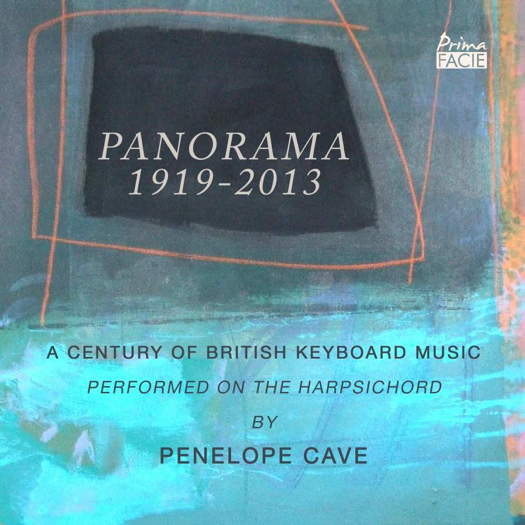 SPONSORED: CD Spotlight. A Fantastic Collection. Penelope Cave Panorama CD. Little-known harpsichord gems, strongly recommended by Alice McVeigh.
SPONSORED: CD Spotlight. A Fantastic Collection. Penelope Cave Panorama CD. Little-known harpsichord gems, strongly recommended by Alice McVeigh.
All sponsored features >>
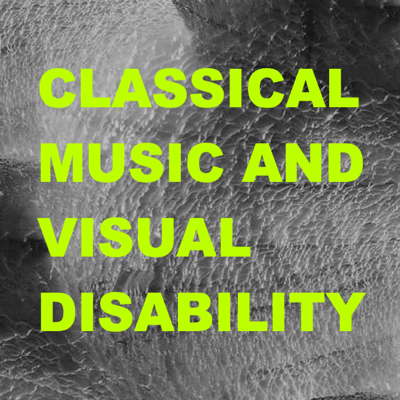 PODCAST: John Dante Prevedini leads a discussion about Classical Music and Visual Disability, including contributions from Charlotte Hardwick, Robert McCarney, Halida Dinova and Giuseppe Pennisi.
PODCAST: John Dante Prevedini leads a discussion about Classical Music and Visual Disability, including contributions from Charlotte Hardwick, Robert McCarney, Halida Dinova and Giuseppe Pennisi.
- Gian Carlo Menotti
- Heino Eller
- children
- didgeridoo music
- Paul Zukofsky
- Derek Hammond-Stroud
- Stephen Gadd
- Hunter Noack
A Varied and Fascinating Evening
KEITH BRAMICH experiences music by Noriko Koide, Saint-Saëns, Prokofiev and Bartók from pianist Mao Fujita and the Finnish Radio Symphony Orchestra conducted by Elim Chan, live at the Helsinki Music Centre in Finland
There were surprises, both visual and aural, waiting for me at the Helsinki Music Centre last night. This big, glass-fronted modern building sits in a wide, flat, open pedestrianised area, near to its neighbours: the Sibelius Academy and Helsinki City Library. Approaching the Music Centre's main entrance, one can't miss a huge display screen near the doors, showing a mixture of commercial advertising with forthcoming concerts and other events.

Helsinki Music Centre's main entrance, with advertising for last night's concert. Photo © 2024 Keith Bramich
Inside, the main concert hall is dominated by what looks like a huge sculpture of sprawling pipes at the back of the stage, perhaps representing some kind of tree. This is actually part of the Music Centre's new organ, which was unveiled in January this year, and made possible due to a significant donation from the late Kaija Saariaho. Made by Rieger Orgelbau in Austria, it has one-hundred-and-twenty-four stops, is the world's largest modern concert hall organ and when the swell shutters are open, one can see the organ pipes inside. The bizarre-looking piping on the outside of the case is actually the wind system, supplying air to the (sounding) internal pipes, and is both functional and aesthetic - referring artistically to the Pompidou Centre in Paris and to Eila Hiltunen's still controversial 1967 Sibelius Monument nearby in Helsinki (which you can see in the background image on this page).
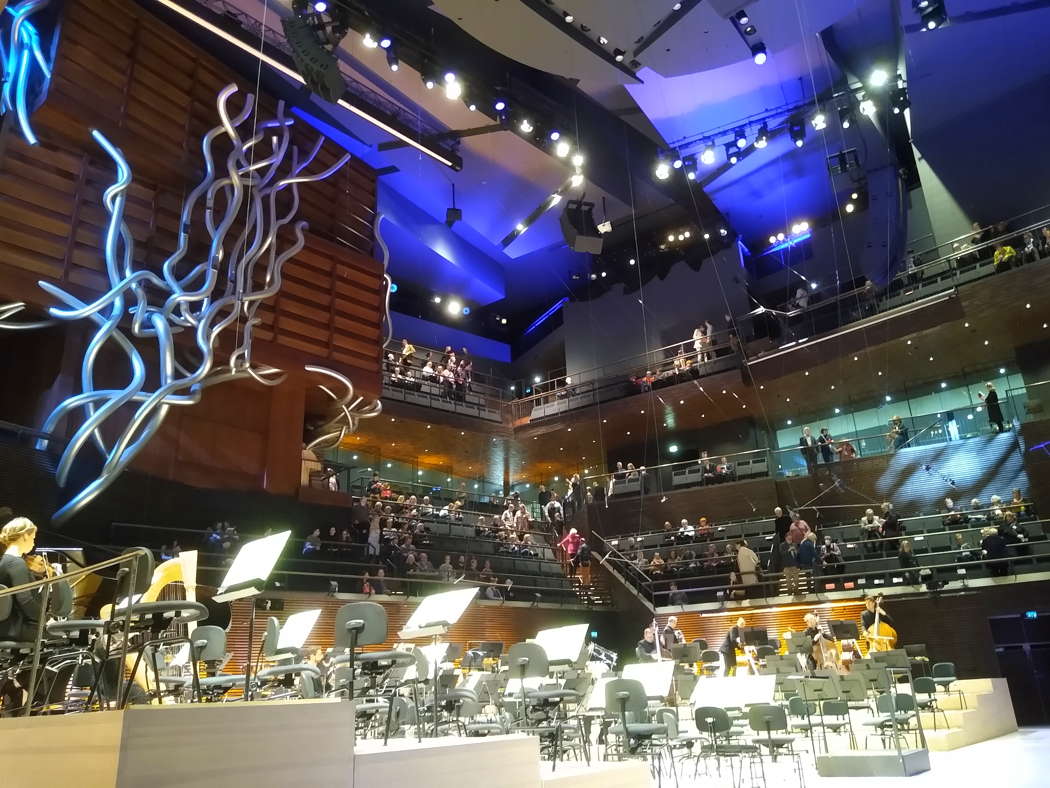
The Centre's new organ, top left, above the stage area.
Photo © 2024 Keith Bramich
The new orchestral work on last night's programme (25 October 2024) was by Japanese composer Noriko Koide (born 1982), who studied in Tokyo with Masao Endo, Yutaka Fujiwara, Akira Fukada and Toshio Hosokawa, and also in the Netherlands, where her teachers included Wim Henderickx, Martijn Padding and Yannis Kyriakides. Her music uses a large variety of unusual timbres and textures, plus performing techniques borrowed from oriental music.
The piece we heard last night, written in 2022 for a commission from BBC Radio 3 in the UK, is Swaddling Silk and Gossamer Rain (referring to a novel by Mariko Asabuki about the development, life and death of silkworms etc). Here it was played by the Finnish Radio Symphony Orchestra, and last night's conductor, Hong-Kong-born Elim Chan, was also in charge at the first European performance, last year in the UK. The first performance took place in Osaka, Japan in 2022.
The music is almost completely static, with occasional events happening, and a loud section about two-thirds through which I thought was 'happy' and 'ethereal' rather than dramatic. The work begins with vibraphone and with the string section making subtle percussive effects. The special effects here include a kind of rain effect, for example, created by various sections of the orchestra, with their mouths only. In her full score for this work, Koide explains how to create this effect as follows:
Without having the instrument on the mouth, open and close the lips rapidly as if to say 'mi, mi, mi, mi ...' but without voicing (ie without letting air flow out of the mouth), so as to create pattering sounds.
Her score contains many such directions for different groups of instruments. Others include con la matita battata - using a pencil between the top two strings of violins to create a rattling sound, tremolo pizzicato and even something called scattered pizzicato, where the players are told to scatter the rhythm, so they're not all playing at once. What I thought I heard here was a kind of travelling wave pizzicato, beginning at the back of the first violin section (which I was sitting very near to, in the front row of the auditorium).
As an aside, I also noticed that Koide's very detailed score contains an exact orchestral layout for her work - one which actually wasn't quite followed correctly here in Finland, as it specifies a fairly conventional orchestra layout, with cellos on the conductor's right, whereas the Finnish Radio Symphony Orchestra placed its violas to the right of the conductor, effectively swapping the positions of the cellos and violas. I wasn't familiar with this layout, which Elim Chan used for the whole concert, but it seemed similar to that other common layout with second violins on the conductor's right, which some conductors prefer to give a better 'stereo' sound, but which some string players don't like because the instruments' soundboards are then facing in the wrong direction.
But returning to last night's concert, Elim Chan's conducting was clear, precise and musical. Born in 1986, so not yet forty, she's obviously going places in terms of her profession, and we published this news item about her recently.
The between ten and twelve minute piece faded to silence at the end, with the strings left playing subtle frictional noise. The effect was mesmerising, and the nearly full capacity audience was quiet and attentive. (One phone in the audience did ring for a while during a quiet section, but somehow, in this hall it wasn't very much of a distraction.) Interestingly, the stage lighting was used in a rather controlling manner, at the end of this piece, which had the effect, along with the conductor's gestures, of preventing us from clapping until the lighting changed. The moving TV cameras in the hall were only mildly annoying.
What I discovered later last night, listening to a recording of last year's UK performance of this piece, is that it really does need to be heard live, as some of the special effects, especially the quiet and subtle ones, seem to become lost on a recording, and maybe the visual element of watching the players is a factor here too. Earlier today I could see a recording online of last night's concert, and although clearer, I think my comments still stand.
Watch and listen — Noriko Koide: Swaddling Silk and Gossamer Rain
(ending only) © 2024 Yle
Next we moved to a very different sound world when Japanese pianist Mao Fujita (born 1998) came on stage to play the most popular of Camille Saint-Saëns' five concertos - No 2 in G minor, Op 22 (1868). Put together quickly for Anton Rubinstein's visit to France, this concerto has been criticised for the disparate styles of its three movements. It's unusual too in that the tempi increase through the three movements, whereas traditionally one would expect a central slow movement. What we actually get is a slow Bachian first movement, then a romping, quirky, music-hall type middle movement, sparkling, happy and full of fun, which could almost have come from The Carnival of the Animals. The last movement is a whirlwind presto saltarella dance.
Mao Fujita, playing from memory, his head slightly shaking through some of the first movement, had this concerto well under his fingers, and this was a snappy, together performance, especially fun in the middle movement.
Watch and listen — Saint-Saëns: Allegro scherzando (Piano Concerto No 2)
(extract) © 2024 Yle
Even younger than last night's conductor, Mao Fujita studied in Japan, has won a series of prizes, most recently last year's 2023 Opus Classic Award Young Artist of the Year, recorded a series of albums for Naxos until 2021 and then jumped ship to Sony Classical, with whom his recordings include the complete Mozart piano sonatas. He has appeared at the Edinburgh and Verbier Festivals, with many top orchestras and at Carnegie Hall in New York. So his is another career to watch.
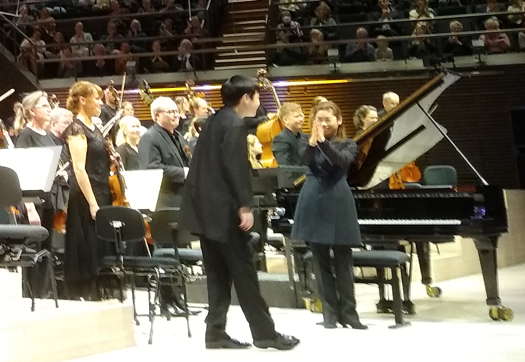
Elim Chan applauds Mao Fujita at the end of his Helsinki Saint-Saëns performance. Photo © 2024 Keith Bramich
Fujita treated us to a short encore - a gentle and romantically played Rachmaninov prelude from 1904 - the one in D, Op 23 No 4, marked Andante cantabile.
During the interval, I went to search in vain for a concert programme booklet. They had all gone, but a couple sitting next to me kindly gave me one of theirs at the end of the concert. Meanwhile a TV interview was taking place at the back of the hall, and the harp, brass and double bass sections of the orchestra were all practising on stage for what was coming next - Sergei Prokofiev's powerful, dramatic and sweeping 'hymn to free and happy Man' - Symphony No 5 in B flat, Op 100, and representing humankind in many of its different manifestations. Dating from near the end of World War II makes it quite difficult for some people not to interpret this music as programmatic battle music.
The first movement, Andante, is a kind of introduction, or marshalling of forces. Two very different themes become intertwined during the development section. The scherzo second movement - Allegro marcato in Prokofiev's 'toccata'-style - travels through a series of different melodies. Antti Häyrynen's programme notes for this concert, translated by Susan Sinisalo, suggest that, at the end of this movement, '... the string and piccolo retorts whistle like bullets past the scherzo theme, which finally crashes into a wall'.
The third movement, a slow, Romantic and dreamy waltz, builds to an agonised climax and then drops away again towards a quiet ending. If anyone in the hall didn't notice the Adagio third movement segue into the Finale's playful, impish and at times ironic Allegro giocoso, the hall lighting again gave a clue, changing colour at this moment, although this was more obvious in the hall than on the TV recording.
Watch and listen — Prokofiev: Adagio / Allegro giocoso (Symphony No 5)
(extract) © 2024 Yle
Both Mao Fujita, after his encore, and Elim Chan and the whole orchestra, at the end of this majestic Prokofiev performance, turned through 180 degrees to bow to the section of the audience behind the stage, as described similarly at the end of a Nottingham UK concert, reviewed by Mike Wheeler the other day. I couldn't help thinking what a pity it is that we're not all as thoughtful to each other as this all of the time.
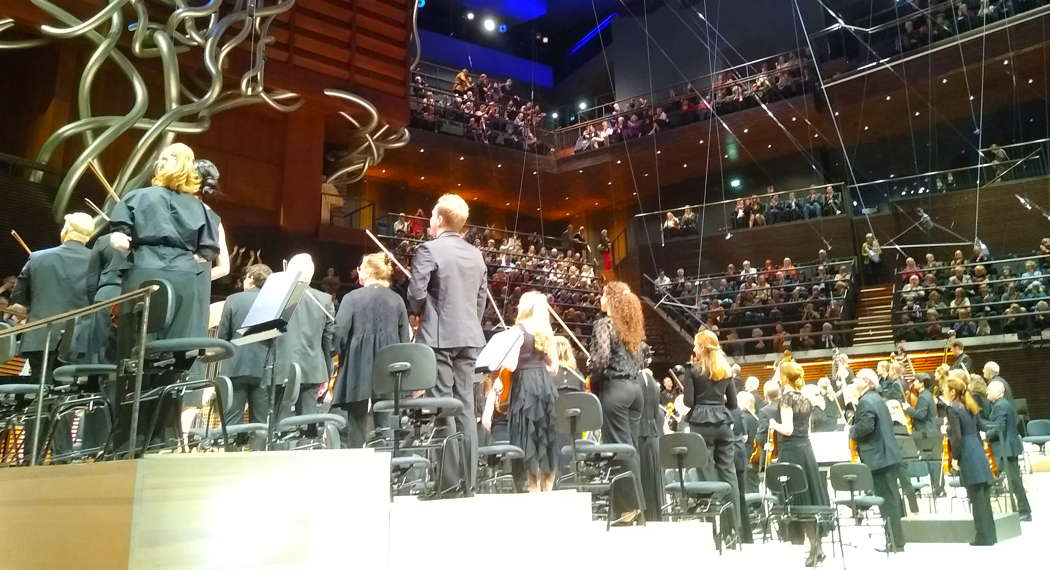
Conductor Elim Chan and the entire Finnish Radio Symphony Orchestra turn through 180 degrees to bow to the audience behind them.
Photo © 2024 Keith Bramich
But this wasn't quite the end of the evening. After ten minutes of clearing up and resetting the stage, the hall lighting changed yet again to provide a more intimate chamber setting, and three members of the orchestra came back on stage to play Béla Bartók's Contrasts of 1938. Influenced by jazz, Hungarian and Romanian dance music, and apparently also by the 'Blues' movement from Ravel's Violin Sonata, the 'contrasts' here can be seen in various ways. Firstly the three instruments are highly contrasting - Tuuli Talvitie's two violins - she had tuned a second one in advance for the last movement's scordatura - with Giuseppe Gentile's two clarinets - again he made lightening fast changeovers while the music continued - and Jouko Laivuori's mostly accompanying piano.
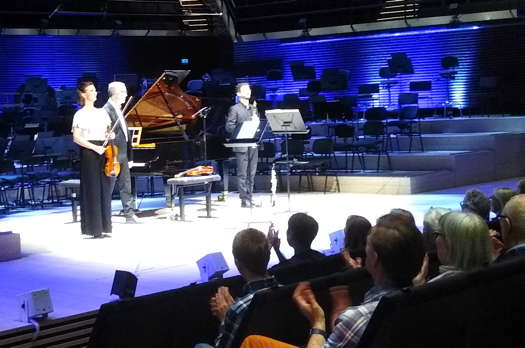
Tuuli Talvitie, Jouko Laivuori and Giuseppe Gentile acknowledge applause at the end of Contrasts. Photo © 2024 Keith Bramich
Then there's the contrast between new (jazz) and old (the Hungarian and Romanian traditional music), and also the contrasting nature - particularly of speed - between the work's three movements - Recruiting Dance (with clarinet cadenza), Relaxation and Fast Dance (with violin cadenza), all performed excellently, to end a varied and fascinating evening of surprises from the Helsinki Music Centre.
Watch and listen — Bartók: Fast Dance (Contrasts)
(ending) © 2024 Yle
You may be able to listen to and watch this concert from home. This URL works for me, today, in Helsinki, but I'm not sure how long it could still be available for, or from where other than Finland it might be watchable:
https://areena.yle.fi/1-71177133
Copyright © 26 October 2024
Keith Bramich,
Helsinki, Finland



